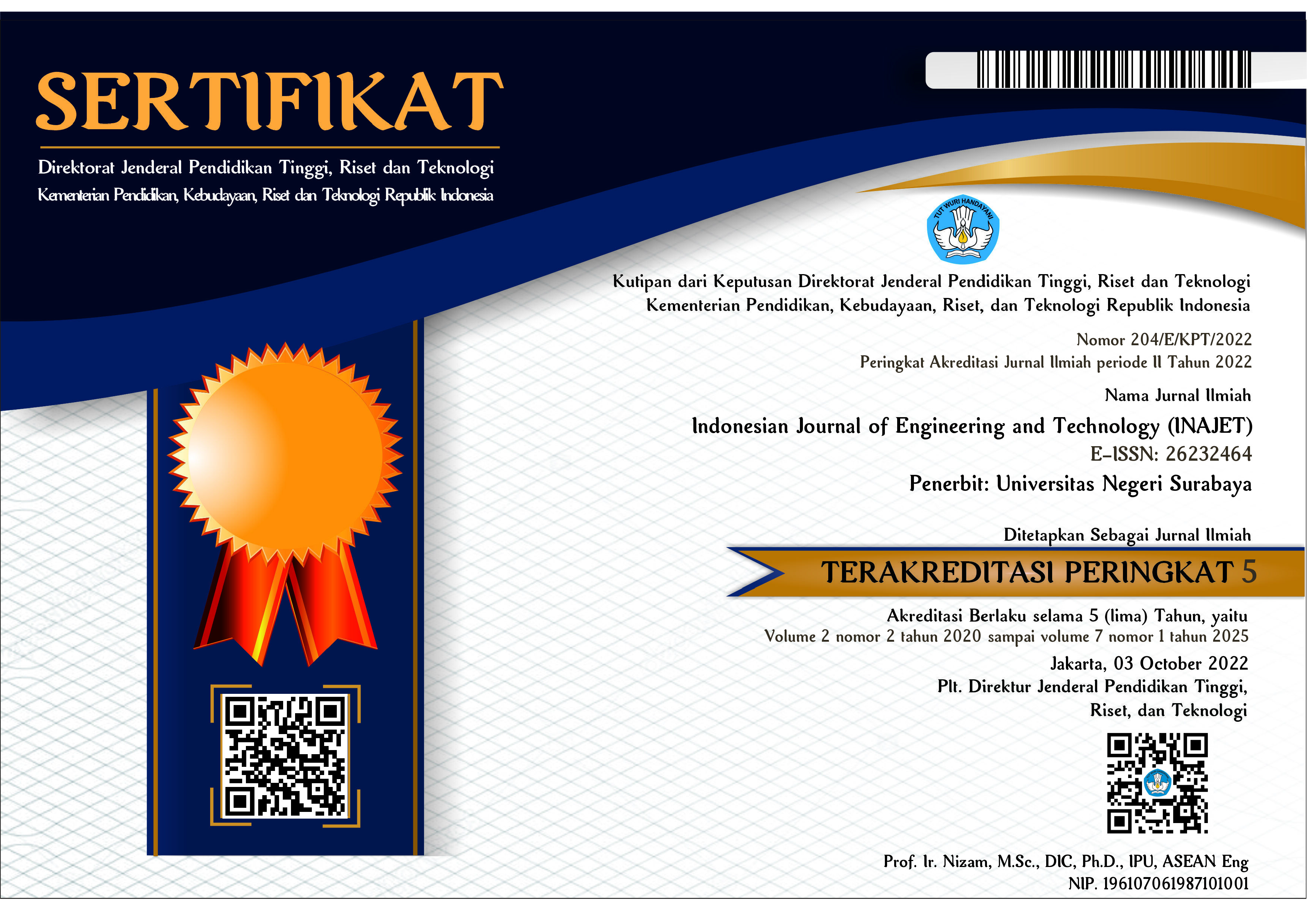Technical Analysis of Lightning Arrester Replacement to Improve Customer's Power Grid Reliability
DOI:
https://doi.org/10.26740/inajet.v8n1.p33-40Keywords:
Lightning Arrester, Lightning Protection, Overvoltage, Power Network TreatmentAbstract
The reliability of the power distribution network in the tropics is particularly vulnerable to thunderstorm disturbances, which can cause asset damage and service interruptions. Lightning arrester (LA) as a primary protection component experiences performance degradation over time due to environmental factors, which has the potential to cause protection failure to thermal runaway. This study aims to conduct a technical analysis of the urgency of replacing existing LA units through a quantitative evaluation of isolation prisoners and a comparison of technical specifications with modern LA. The research methodology refers to the standard testing of insulation resistance with high DC voltage (2.5 kV - 5 kV), where values below the critical threshold of 1 Giga Ohm (GΩ) are identified as indicators of insulation failure after corrective cleaning measures are ruled out. The researchers analyzed that the value below the standard indicated a significant risk of leakage current that could trigger catastrophic failure of the Metal Oxide Varistor (MOV) block. The results of this analysis are expected to provide a strong technical justification for predictive maintenance policies, in order to improve surge protection capabilities, reduce the rate of disturbances, and ultimately strengthen the reliability of the electrical system comprehensively.
References
Boukhouna, M., Nekhoul, B. and Khelifi, B. (2024) ‘Time domain modeling of lightning transients in grounding systems considering frequency dependence and soil ionization’, Electric Power Systems Research, 234(April), p. 110542. Available at: https://doi.org/10.1016/j.epsr.2024.110542.
Castro, W.S. et al. (2022) ‘Optimal placement of surge arresters for transmission lines lightning performance improvement’, Electric Power Systems Research, 202(September 2021). Available at: https://doi.org/10.1016/j.epsr.2021.107583.
De Conti, A. and Leal, O.E.S. (2026) ‘Calculation of lightning-induced voltages on a large-scale distribution network using the JMarti model’, Electric Power Systems Research, 251(September 2025), p. 112232. Available at: https://doi.org/10.1016/j.epsr.2025.112232.
Dolník, B. and Šárpatakyľ (2023) ‘Assessing the impact of long-term operation, pollution and housing damage on the medium voltage surge arresters using non-destructive diagnostic techniques’, Electric Power Systems Research, 222(May), p. 109508. Available at: https://doi.org/10.1016/j.epsr.2023.109508.
Dong, B., Yao, X. and Zhao, J. (2025) ‘Lightning impulse discharge characteristics and insulation coordination for the regulation and assessment of 35 kV insulator strings with zero-value and arresters in lightning-prone mountainous areas’, Electric Power Systems Research, 247(May), p. 111776. Available at: https://doi.org/10.1016/j.epsr.2025.111776.
Grebović, S. et al. (2023) ‘The principles of a new line surge arrester’s transient current measurement system’, Electric Power Systems Research, 223(June). Available at: https://doi.org/10.1016/j.epsr.2023.109633.
Napolitano, F. et al. (2023) ‘Evaluation of lightning-originated stress on distribution class surge arresters✰’, Electric Power Systems Research, 223(June), p. 109593. Available at: https://doi.org/10.1016/j.epsr.2023.109593.
Reski, S. et al. (2024) ‘Lightning arrester aging rate due to contamination by soluble pollutants’, 13, pp. 119–124.
Ritonga, Z.A., Taringa, A.S.P. and Arzya, S. (2022) ‘Study Analysis of Lightining Arrester Installation Location At Substations’, Infokum, 10(3), pp. 121–128.
Sabiha, N.A. and Alkhammash, H.I. (2023) ‘Performance evaluation of distribution and low-voltage networks under direct lightning flashes with paralleled triac-surge arrester’, Electric Power Systems Research, 225(August), p. 109851. Available at: https://doi.org/10.1016/j.epsr.2023.109851.
Silakhori, K., Mirzaie, M. and Ahmadi, I. (2025) ‘Analysis of Multi Chamber Arc-Quenching Arrester Performance under Different Lightning Waveform Characteristics Based on Finite Element Method’, Electric Power Systems Research, 246(April), p. 111694. Available at: https://doi.org/10.1016/j.epsr.2025.111694.
Souto, L., Taylor, P.C. and Wilkinson, J. (2023) ‘Probabilistic impact assessment of lightning strikes on power systems incorporating lightning protection design and asset condition’, International Journal of Electrical Power and Energy Systems, 148(December 2022), p. 108974. Available at: https://doi.org/10.1016/j.ijepes.2023.108974.
Utomo, R.M. et al. (2025) ‘Analysis the Distance of Lightning Arrester to Transformer as Protection Against Lightning Disturbances’, (Ictrops), pp. 349–356. Available at: https://doi.org/10.2991/978-94-6463-732-8_32.
Wadie, F. (2023) ‘Evaluative analysis for standardized protection criteria against single and multiple lightning strikes in hybrid PV-wind energy systems’, Electric Power Systems Research, 218(February), p. 109227. Available at: https://doi.org/10.1016/j.epsr.2023.109227.
Widagdo, R.S. et al. (2025) ‘Design and Installation of Lightning Arrester System at Karitas Yogyakarta Junior High School’, 6(1), pp. 7–19.
Xue, H. et al. (2023) ‘Parametric study of equivalent homogeneous earth method for overhead lines above a multi-layer earth’, Electric Power Systems Research, 223(June). Available at: https://doi.org/10.1016/j.epsr.2023.109602.
Zhao, Y. et al. (2022) ‘Induced voltage at two poles of 10kV parallel distribution line caused by direct lightning strike on the phase wire of adjacent line’, Electric Power Systems Research, 211(July), p. 108215. Available at: https://doi.org/10.1016/j.epsr.2022.108215.
Downloads
Published
How to Cite
Issue
Section
 Abstract views: 50
,
Abstract views: 50
, PDF Downloads: 60
PDF Downloads: 60











